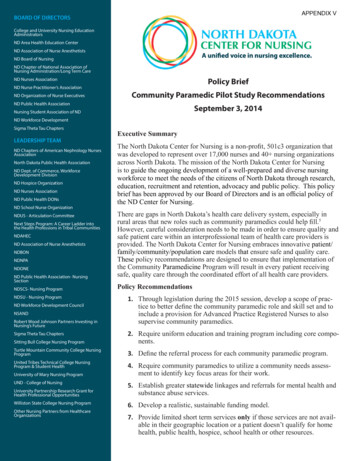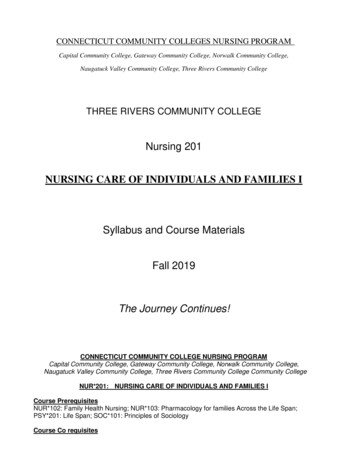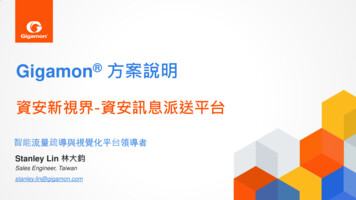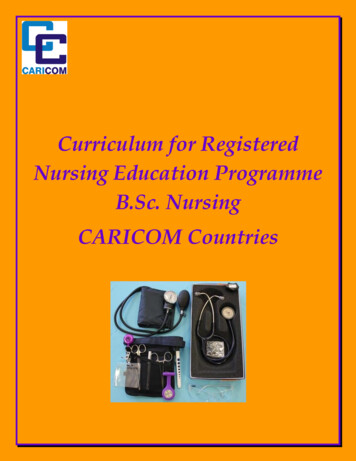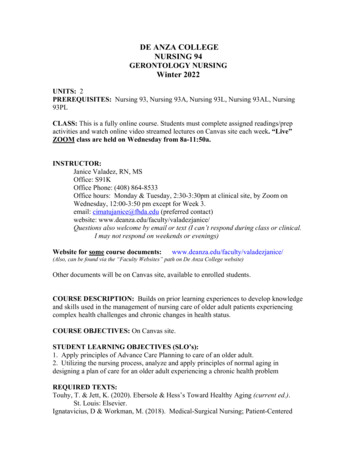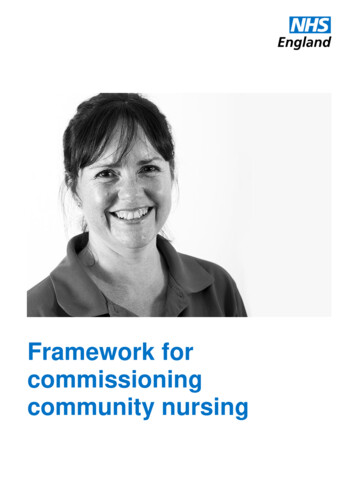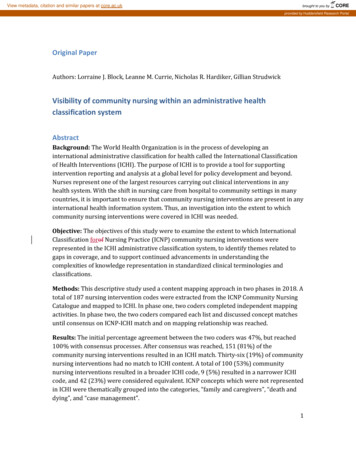
Transcription
View metadata, citation and similar papers at core.ac.ukbrought to you byCOREprovided by Huddersfield Research PortalOriginal PaperAuthors: Lorraine J. Block, Leanne M. Currie, Nicholas R. Hardiker, Gillian StrudwickVisibility of community nursing within an administrative healthclassification systemAbstractBackground: The World Health Organization is in the process of developing aninternational administrative classification for health called the International Classificationof Health Interventions (ICHI). The purpose of ICHI is to provide a tool for supportingintervention reporting and analysis at a global level for policy development and beyond.Nurses represent one of the largest resources carrying out clinical interventions in anyhealth system. With the shift in nursing care from hospital to community settings in manycountries, it is important to ensure that community nursing interventions are present in anyinternational health information system. Thus, an investigation into the extent to whichcommunity nursing interventions were covered in ICHI was needed.Objective: The objectives of this study were to examine the extent to which InternationalClassification forof Nursing Practice (ICNP) community nursing interventions wererepresented in the ICHI administrative classification system, to identify themes related togaps in coverage, and to support continued advancements in understanding thecomplexities of knowledge representation in standardized clinical terminologies andclassifications.Methods: This descriptive study used a content mapping approach in two phases in 2018. Atotal of 187 nursing intervention codes were extracted from the ICNP Community NursingCatalogue and mapped to ICHI. In phase one, two coders completed independent mappingactivities. In phase two, the two coders compared each list and discussed concept matchesuntil consensus on ICNP-ICHI match and on mapping relationship was reached.Results: The initial percentage agreement between the two coders was 47%, but reached100% with consensus processes. After consensus was reached, 151 (81%) of thecommunity nursing interventions resulted in an ICHI match. Thirty-six (19%) of communitynursing interventions had no match to ICHI content. A total of 100 (53%) communitynursing interventions resulted in a broader ICHI code, 9 (5%) resulted in a narrower ICHIcode, and 42 (23%) were considered equivalent. ICNP concepts which were not representedin ICHI were thematically grouped into the categories, “family and caregivers”, “death anddying”, and “case management”.1
Conclusions: Overall, the content mapping yielded similar results to other content mappingstudies in nursing. However, it also found areas of missing concept coverage, difficultieswith inter-terminology mapping, and further need to develop mapping methods.Keywords: World Health Organization, Classification, Nursing Informatics, MedicalInformatics, Data Collection, Terminology, Community Health Services, StandardizedNursing TerminologyIntroductionThe digitalization of health care information is increasing rapidly. The use ofstandardized terminologies and classifications to unambiguously represent this informationis a fundamental principle in the field of clinical and biomedical informatics [1]. The WorldHealth Organization Family of International Classifications (WHO-FIC) contains a suite ofstandardized administrative classification products which are used internationally andnationally to statistically report on the health and well-being of individuals, families,communities, and populations [2]. The WHO-FIC includes the International Classification ofDiseases (ICD), the International Classification of Functioning, Disability and Health (ICF),and the International Classification of Health Interventions (ICHI) (in development)[2].ICHI is the newest classification of this group and its purpose is to provide acommon tool for reporting and analyzing health care interventions [3]. Currently in its Beta2 release, aA series of international evaluative projects hadve been planned for the Beta-1release (e.g., terminology mapping, standard case reporting) [4]. The goal of the evaluationprojects wereis to ensure the terminology is: (1) robust enough to capture interventionsprovided across the continuum; (2) appropriate to cover interventions provided bydifferent health care disciplines; (3) has a functional browser tool; and (4) has the depth ofeducational and training material sufficient to support its future use [4]. Evaluations andreleases of the ICHI Beta version are ongoing, with a future goal of seeking World HealthAssembly approval in 2019 [5].This descriptive paper represents one of these international evaluative projects.Its objectives wereare (1) to examine the ability of ICHI to represent community nursinginterventions found in the International Classification for Nursing Practice (ICNP), (2) toprovide recommendations for content development, and (3) to support continuedadvancements in understanding the complexities of knowledge representation instandardized clinical terminologies and classifications. In this context, a community nursingintervention refers to the actions carried out by nurses practicing in a community setting tosupport the health and well-being of patients, families, communities, or populations [6–8].2
The multiple research methods used to achieve these research objectives were based on acontent mapping approach. Specifically, two clinical experts individually matchedequivalent (or near equivalent) concepts from ICNP to ICHI. The results were compared andreviewed until matching consensus was research between the two coders. This study isunique in that it is the first to bring a community nursing care perspective to the evaluationof ICHI, informing broader discussions about the representation of health care activity andresourcing in administrative classifications. To the best of our knowledge, it is also the firstpublished study to evaluate aspects of the 2017 ICHI Beta-1 release.BackgroundCommunity NursingWith rapid population growth occurring worldwide, health care systems arechallenged, both socially and economically, with changing demographics, shifting diseasepatterns, increased prevalence of chronic diseases, and financial reforms [9]. The delivery ofhealth care services outside of acute care centers is necessary to manage this complexphenomenon. Therefore, community nursing is an essential global service. The WorldHealth Organization defines community nursing as a service which “combines the skills ofnursing, public health and some phases of social assistance and functions as part of the totalpublic health programme for the promotion of health, the improvement of the conditions inthe social and physical environment, rehabilitation of illness and disability”[10,11].Nurses practicing in the community context provide care which directly improvesthe health outcomes of individuals, families, communities, and populations [12]. This can beattributed to the ethos of community nursing, where work is founded on the principles ofsocial justice, holistic care, equity, ethics, community capacity building and empowerment,and action upon the intersectoral determinants of health [12]. The types of interventionscommunity nurses provide include home visits for new baby and family care, school classeson the topic of sexual health, wound care, interventions which address elder abuse, andadvocacy for health and wellness initiatives [13]. Despite the increasing internationalrecognition and support for this nursing service, there remains a limited understanding ofits full impact on health outcomes [14–16].The International Classification of Health InterventionsSince its early initiation, ICHI was envisioned as a standardized classification systemto describe health care interventions provided by health professionals [17]. To structure3
the context of this work, developers defined health intervention to mean “an act performedfor, with or on behalf of a person or a population whose purpose is to assess, improve,maintain, promote or modify health, functioning or health conditions” [18]. The purpose ofICHI was to facilitate the comparison of semantically equivalent information at local,national, or international levels; act as a national classification for countries where noexisting (or outdated) intervention classification systems existed; and complement theexisting WHO-FIC classifications, ICD and ICF [17,18].In 2007, working groups within the WHO-FIC began to direct the development ofthis international classification. A Categorial Structure, developed by the EuropeanStandard Body CEN TC 251/International Standards Organization TC 215 group, was usedto build and define the included ICHI content including a framework that defined the wayconcepts would be related to each other [4,17–19].Semantic categories within ICHI are structured into three axes: Target: the semantic categories which the intervention (action) is carried out on, to,or with (e.g., person, family, community)Action: the semantic categories describing the intervention done by the actor to thetarget (e.g., assessment, treating, assisting, informing)Means: the semantic categories defining the intervention (action) method orprocess (e.g., method, approach, technique)In 2012, an Alpha version of the classification became available (in excel format) toaffiliated researchers and partners [18]. After several years, iterations, and evaluativeprojects, the Beta version of ICHI became available to the public through a functional webbrowser. This browser allowed users to search through over 7,000 concepts in fourcategory sections [3,4].1.2.3.4.Interventions on Body Systems and Functions (e.g., biomedical body systems)Interventions on Activities and Participation (e.g., activities of daily living)Interventions on the Environment (e.g., products, services, systems)Interventions on Health-related Behaviours (e.g., safety, lifestyle)In a recent release of ICHI, developers defined the use of extension codes allowingfor the broadening of the intervention classification (e.g., assistive and therapeuticproducts) [4]. This inclusion has allowed for the classification to grow and to continue inrelevance [20]. In late 2018, ICHI released a Beta-2 version which included a noted increasein concept coverage and updated resource materials.The International Classification for Nursing Practice4
The International Council of Nurses (ICN) represents around 20 million nurses inmore than 130 nursing associations across the world [21]. ICN develops and distributesICNP, a standardized terminology system for nursing [22,23]. ICNP conforms to 18104:2014Health informatics - Categorial structures for representation of nursing diagnoses andnursing actions in terminological systems (previously published as ISO 18104:2003)[24,25]. As a formal standardized nursing terminology, ICNP provides a polyhierarchicalframework into which nursing diagnoses, interventions, and outcomes are structured andcoded for multiple uses [26].Since 2005, ICNP has utilized the Web Ontology Language (OWL) to permitautomated description logic reasoning, to ensure coherence, and to support theclassification development [27]. Due to its robustness and compliance to internationalstandards, ICNP is widely recognized as a standard terminology appropriately suited todescribe the professional practice of nursing. The WHO has included ICNP as a RelatedClassification in the WHO-FIC, using it to extend coverage into the domain of nursing [28].As an invested partner in the advancement of ICHI, ICN has maintained a workingrelationship with the ICHI Development Task Force. For example, in 2016 researchersmapped 100 frequently recorded ICNP nursing interventions from acute care settings to the2015 ICHI Alpha release [29]. The purpose was to evaluate the degree of ICNP contentcoverage in ICHI, as well as, provide recommendations for additions and changes. Theresearchers in this study found that 80% of ICNP concepts were represented in ICHI. Theyalso found missing content coverage, ambiguities in concept description, and uncertaintiesin the semantic matching [30].MethodsThis is a descriptive research study. The presented work was conducted using acontent mapping approach (the most common method used to perform terminologymapping [29,31–35]) in two main phases over July and August, 2018. In phase one, twocoders completed independent content mapping activities. In phase two, the two coderscompared each list and discussed content matches until consensus on ICNP-ICHI match andon mapping relationship was reached. Additional details about these phases are includedbelow.The community nursing interventions used in this study were derived from theICNP Community Nursing Catalogue. This catalogue was developed in 2011, updated mostrecently in 2017, and created in partnership between the Scottish Government and the ICN[36]. The ICN Guidelines for Catalogue Development encourages worldwide validationthrough global use. The ICNP Community Nursing Catalogue contains 187 community5
nursing interventions [36]. These interventions (source) were used to identify if there wereany equivalent ICHI pre-coordinated interventions (target) in the draft 2017 Beta-1 release.This study did not require research ethics board review through the authors’University settings as it had no human subjects/materials and was considered a qualityassurance and quality improvement evaluation [37,38].Phase 1: Independent Content MappingIn phase one, two coders (LB, GS) were involved in independently mapping 187ICNP community nursing interventions to ICHI. The mapping process used by each coder toidentify a possible ICNP match to an ICHI intervention was completed using the ICHI onlinebrowser and followed the method outlined in Figure 1. For example, if exact or equivalentterms were not immediately found in the ICHI browser search bar, the coders manuallysearched through the axial categories (e.g., Interventions on Body Systems and Functions),drilling down through the hierarchal layers (e.g., Interventions on the IntegumentarySystem) until a match (or not) was found. These mapping processes facilitated differentmechanisms to manage the search of concepts amongst the thousands of concepts availableto view in the ICHI browser. Different mapping relationships were further considered asequivalent or exact (e.g., dog - dog), broader than (e.g., dog - mammal), or narrower than(e.g., dog - Siberian husky) based on their semantic representation.The coding was performed in batches to ensure consistency in process and to allowthe coders to refine the process over time. This was a mechanism that was established toimprove the quality and reliability of the mapping process overall. In the first batch, asystematic sampling method was used to mark every twentieth ICNP intervention for a totalof ten (n 10) ICNP intervention codes. This small number allowed the coders to refine themapping process without having a potentially negative influence on the level of agreementcalculated at the end of the study. In the second batch, a total of thirty (n 30) interventionswere selected for coding. This number was selected as it allowed for an additionalopportunity to include more types of interventions for refinement in the mapping process.Lastly, the remaining interventions (n 147) were coded in the final batch. Other membersof the team (LC, NH) were regularly consulted throughout this mapping process and actedto ensure the decision process (Figure 1) was maintained. The mapping took place over aperiod of two months (July and August of 2018).6
Figure 1. Decision process for mapping ICNP to ICHIPhase 2: Reaching ConsensusIn phase two, the independent mapping results were compiled into one sharedspread sheet. The file contained a list of all ICNP interventions from a particular batch andthe matched ICHI intervention from each coder. A percentage agreement between the twocoders was calculated for each batch. When the coders had different findings from oneanother, a discussion was carried out until agreement of one mapping match was met. Thecoders also collectively determined the type of mapping relationship for each conceptmatch (equivalent, broader than, narrower than, or no match). These methods are typicallyfollowed in content mapping methods to resolve disagreements and come to consensus[29]. As a result, a single ICHI intervention (or no match) was identified for each ICNPintervention. Once completed, final mapping results were presented and discussed amongstthe entire research team, providing opportunity to examine themes and trends of thefindings.Results7
Phase 1: Independent Content MappingIn phase one, independent coding was completed for all of the ICNP interventions.The percentage agreement between the two coders was 47% (n 88). There was noagreement between the coders in the remaining cases (n 99). Table 1 shows examples ofcases where the coders identified the same ICHI code, where the coders both identified noICHI code, and where there was no initial mapping agreement.Table 1. Phase 1 Examples of Independent Content Mapping ResultsICNP SourceTerm/CodeICHI Term/Code bycoder #1ICHI Term/Code bycoder #2Coding Result10030440SU2.PN.ZZSU2.PN.ZZAgreement (map)Advising aboutEmploymentAdvising about workand employmentAdvising aboutwork andemployment10024570No ICHI matchidentifiedNo ICHI matchidentifiedAgreement (no map)PZB.PP.ZZCounselling, notelsewhere classifiedNo ICHI matchidentifiedDisagreement(different ICHI codewas atientPhase 2: Reaching ConsensusDuring phase two, consensus was achieved for all ICNP interventions (source)through discussion between the two coders. A total of 151 cases (81%) of ICNP interventionconcepts resulted in an ICHI match. A total of 36 cases (19%) of ICNP intervention conceptsresulted in no ICHI match. In the cases where an ICHI match was identified, a conversationensued about whether ICHI was equivalent to ICNP, whether ICHI was narrower than ICNP,or whether ICHI was broader than ICNP. A summary of the findings and examples areshown in Table 2. Within content mapping methodology, this is a typical approach toidentifying equivalency[32–35,39,40].8
After the two coders completed their mapping consensus work, results were sharedwith the full research team. As a group, we examined missing ICNP concepts and foundthematic groupings which are important practice areas for community nursing. Theseinclude intervention concepts related to family and caregivers; death and dying; and casemanagement (Multimedia Appendix 1: ICNP to ICHI Community Nursing Mapping Results).Table 2. Summary of Mapping Results in Phase Two and Examples of Mapping SpecificityMapping ResultN(%)ExampleSource: ICNP InterventionTermTarget: ICHI Code and TermICHI was equivalentto ICNP4210030558(23)Assessing Bowel ContinenceKTK.AA.ZZICHI was narrowerthan ICNP9(5)10032994SSK.PM.ZZTeaching about EffectiveParentingEducation about parent-childrelationshipsICHI was broaderthan ICNP100 10030429(53)Administering VaccineDTB.DB.AENo match3610032859(19)Supporting Family CopingProcess(none found)Assessment of defecationfunctionsOther immunization, notelsewhere classifiedDiscussionThe inclusion of community nursing interventions in administrative classificationsis essential when evaluating the health and well-being of individuals, families, communities,and populations. The results of this study indicated that 151 of 187 (81%) ICNP communitynursing intervention concepts were represented (equivalent, broader, and narrowermatches combined) in the Beta-1 release of ICHI. While there is no industry gold standard9
with which to judge these results, we suggest the representation of community nursinginterventions in ICHI appears encouraging. For the 36 (19%) concepts which did not havematches in ICHI, further analysis revealed a) instances where ICHI was missingrepresentative concepts and b) inherent differences in terminology system design [29,30].Additionally, the results highlight key considerations related to the representation ofknowledge in administrative terminology systems.Missing concept coverage in ICHIA total of 36 ICNP intervention concepts were not represented in the ICHIclassification. After examining these missing concepts in greater detail, we were able tothematically group several of the intervention concepts into “family and caregivers”, “deathand dying”, and “case management”. Inclusion of concepts in ICHI, which consider thesethemes, is recommended to ensure related concepts are available for administrativereporting and analysis. A focus on the collection of relevant information about communityhealth care provision is necessary to gain knowledge about general health service provision[9].It is within the scope of practice for community nurses to care for the families andcaregivers of a patient [41–46]. In our sample of 187 community nursing interventions, tenICNP concepts related to family or caregivers were not represented in ICHI (i.e., 10032859Supporting Family Coping Process; 10032068 Monitoring For Impaired Family Coping). Inparticular, this was noted for those concepts specific to community nursing interventionsfor caregivers of young children (i.e., 10032837 Supporting Caregiver During Weaning;10033093 Teaching Caregiver About Toilet Training 10032973 Teaching Infant Massage).This practice is often performed by visiting nurses concerned about the functioning anddevelopment of young families. Mapping difficulties were also noted when attempting tomatch ICNP concepts with the specific word “caregiver”, as ICHI uses different terms intarget descriptions (e.g., family, friend, peers, colleagues, neighbors, and communitymembers). Although each of these ICHI target terms could be a “caregiver”, in practice, theyare not always equivalent. Caring for the caregiver and family is essential to the overallhealth of a population, and necessary to account for in administrative classifications[41–46].Another area with missing content coverage was noted for those specific ICNPintervention concepts on “death” and “dying” (i.e., 10041254 Supporting Dignified Dying;10033296 Verifying Death). In the ICHI Beta-1 version, no codes specifically used theseterms, or even the broader terms of “palliative care”, “hospice” or “end of life”. This area ofpractice has always been part of nursing, and is increasingly viewed an essential service inthe community setting [13]. Cultural, legal, and practice changes are also occurring on thistopic of end of life care. For example, in Canada, Medical Assistance in Dying is a legally10
administered intervention provided by physicians and nurse practitioners and is supportedby other health care providers, such as registered nurses [47]. Ensuring the representationof appropriate end of life concepts in administrative classifications is necessary as itsupports the evaluation of health interventions provided in the community setting.A theme emerged related to missing content for community nursing casemanagement. Case management is the coordination of a wide variety of services, whichbenefit the care of individuals, families, and communities [13]. For example, the role ofcommunity nursing in case management activities may include screening of health andfunctional needs, arranging services, planning care, ongoing re-assessment, and provision ofcontinuity between services [13]. In the report, Crossing the Quality Chasm [48], the need toimprove the organization and coordination of care around the needs of a person was statedas a measure to improve the health care system. Though the mapping between ICNP andICHI did find matches between related concepts (i.e., 10030455 Advising About Housing),several were not found to be represented (i.e., 10032598 Referring To Housing Service;10030625 Assessing Housing Condition; 10030493 Arranging Transport Of Device). Thesemissing concepts describe the type of ongoing case management community nurses provideon behalf the person(s) outside of institutionalized care. It is again recommended that casemanagement intervention concepts continue to be developed and added to administrativeclassification systems as a means to increase our understanding and inform future healthcare decisions.Foundational design decisions of a classification systemThe foundational design of a classification or terminology system considers scope,hierarchical orientation, concept granularity, and concept placement. Standards, such as ISO18104:2014 Health informatics - Categorial structures for representation of nursingdiagnoses and nursing actions in terminological systems, direct design decisions. Forexample, ICHI concepts are required to include a defined target, action, and means. ICNPinterventions are required to have a target and action, but no means. When researchersconduct inter-terminology mapping exercises, discord between concept representationsmay be related to these foundational development decisions.In this mapping activity, several missing ICNP matches were related to differences inconcept granularity (i.e., specificity or level of detail for related concept). For example, theICNP concept 10033126 Teaching Patient was determined to have ‘no match’ in ICHI. Thiswas not due to the lack of codes in ICHI which could be used to describe patient education.Rather, the ICNP concept was ‘broader than’ what was available in ICHI. One may then ask,why not choose an ICHI concept which was more specific and call it a ‘narrower match’? TheICNP concept 10033126 Teaching Patient could have been a ‘narrower match’ to over 300 specific ICHI educational concepts. Practically speaking, the terminology coders could not11
make a meaningful one-to-one match. The following examples represent additional ‘broaderthan’ ICNP concepts which did not have meaningful matches in ICHI. 10030673 Assessing During Encounter10024570 Supporting Caregiver10032844 Supporting Family10031912 Managing Disease10031965 Managing Symptom10033086 Teaching Caregiver10033126 Teaching PatientThis example highlights the complexities of knowledge representation whenattempting to map terminologies of varying granularity and overlapping coverage. Whendecisions are made on how a terminology or classification is to be foundationallystructured, and then mapped to another with a different foundational base, clashes insemantic matching may be part of the expected results.Representation of Community Nursing PracticeAs noted above, a total of 151 (81%) ICNP community nursing interventions arerepresented in ICHI. Two-thirds of these concept matches were classified as ‘broader than’(i.e., meaning that an ICNP concept could fit as a ‘child’ into the broader ICHI ‘parent’concept). From the vantage of developing an administrative classification to representhealth, it can be understood that there has to be a threshold of low specificity to allow for ahigher aggregation of data. However, the questions remain, as to whether these ‘broaderthan’ ICHI concepts satisfactorily represent nursing care interventions and at what pointknowledge representation turns from meaningful coverage to diluted meaninglessness.In the case of community nursing skin and wound care concepts, 90% were matchedto ICHI as ‘broader than’ (10% no matches). For example, eight skin and wound care ICNPconcepts were rolled up into the closest ICHI match, LZZ.ZY.ZZ Other interventions onintegumentary system, not elsewhere classified. Similar outcomes were found for ICNPconcepts related to prenatal and postpartum care, continence and catheter care, andsupporting care for grief and anxiety (Table 3). If these concepts were subsequentlymapped against health care data, the knowledge represented would be so far compressedinto a vague point of datum, that extracting knowledge back out of it could be lost. These areimportant considerations, especially as these concepts not only represent the care providedby community nursing, but also many other health care professional groups. ICHI is beingdeveloped for countries to report and analyze on health interventions [3]. It isrecommended therefore that ongoing work continues to evaluate the practical use (e.g., tosupport resourcing) of those concept groups frequently mapped as ‘broader than’, in order12
to ensure the meaningful representation of health care phenomena is available inadministrative classifications [20].Table 3. ICNP concepts not elsewhere classifiedICNP concept‘Broader than’ ICHI concept10031117 Diabetic Ulcer CareLZZ.ZY.ZZ Other interventions onintegumentary system, not elsewhereclassified10031690 Malignant Wound Care10032420 Pressure Ulcer Care10032863 Surgical Wound Care10033208 Traumatic Wound Care10033254 Ulcer Care10030710 Assessing Risk For PressureUlcer10030723 Assessing Risk For TransferInjury10031931 Managing Postpartum Care10031949 Managing Prenatal CareNUE.ZY.ZZ Other interventions onfunctions related to pregnancy, notelsewhere classified10030706 Assessing Risk For DepressedMood During Postpartum Period10031769 Managing PostpartumDepressed Mood10031805 Managing Enuresis10031879 Managing Urinary IncontinenceNTD.ZY.ZZ Other interventions onurination function, not elsewhere classified10033135 Teaching Self-Catheterisation10033277 Urinary Catheter Care10035958 Facilitating Grief10031711 Managing Anxiety13
10031851 Managing Negative EmotionAUD.ZY.ZZ Other interventions onemotional functions, not elsewhereclassifiedMapping Methods of Coding and ConsensusThere is no one agreed upon method of mapping concepts from a source to a targetclassification or terminology. Multiple examples of mapping clinical content between interterminology groups, data sets to terminologies, or raw clinical content, exist[23,29,40,49,50]. In this study, we presented a method of using two coders to manually map187 concepts from one sta
Health informatics - Categorial structures for representation of nursing diagnoses and nursing actions in terminological systems (previously published as ISO 18104:2003) [24,25]. As a formal standardized nursing terminology, ICNP provides a polyhierarchical framework into which nursing diagnoses, interventions, and outcomes are structured and





